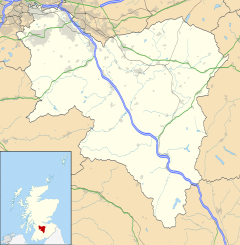Earnock was an ancient estate in an area south of Hamilton in Lanarkshire, Scotland. It extended from the western side of Strathaven Road to the western extremity of the Parish of Hamilton.
| Earnock | |
|---|---|
Location within South Lanarkshire | |
| Language | English |
| Council area | |
| Lieutenancy area | |
| Country | Scotland |
| Sovereign state | United Kingdom |
| Police | Scotland |
| Fire | Scottish |
| Ambulance | Scottish |
Etymology
editSir John Sinclair's Statistical Account of Scotland attributes Earnock to the Celtic Earnogg, “the old son’s possessions” (Sinclair 1791) while Stothers suggests alternatively ‘Ireland’ (Stothers nd). James Johnston's Place-names of Scotland postulates a Gaelic etymology, from earr an achaidh "end/boundary of the field". (Johnston 1892)
History
editEarnock was originally part of the grant of Cadzow to Walter fitz Gilbert (progenitor of the Hamiltons of Cadzow) in 1314. It was received by the progenitor of the Roberton family, Robert de Robertoun, by feudal charter from either Malcolm IV or William I between 1160-1200 (Beverage nd)
The Robertouns were feudal Lairds of Earnock from prior to 1226 – 1296 and 1390 - c 1700. ( The family were dispossessed for signing the Ragman Roll (Rampant Scotland). Simon Robertoun regained Earnock through marriage to a daughter of David fitz Walter of Cadzow (Beverage nd) (Nesbitt A nd) ). It was sold by James Roberton, 12th Laird of Earnock, to a Mr Semple at the turn of the 19th century. He in turn sold the property to A. Millar, Esq., in 1810.
Earnockmuir, part of the original estate was inherited by Sir William Erskine Cochrane,(Hamilton Advertiser 1874) (brother of Lord Dundonald) great grandson of the last Laird of Earnock. He sold it along with part of Annesfield Farm to a Mr Dixon sometime after his retirement in 1819 (Philippart 1820)
Upon Millar’s death his married sister Mrs Williams inherited it, and sold it to Sir John Watson, baronet. None of the Robertons’ house remains although it is said " the great hall was beautifully decorated with armorial bearings of the Robertons, and that the fireplace was remarkable for its carving." (Hamilton Advertiser 1943) Watson and his descendants built a mansion upon the site. (Hamilton Advertiser 1943)
Electric light was introduced to the house in 1881 although the town of Hamilton did not receive electricity until 1903. The house was sold in 1925 and demolished in 1926. (Stothers nd)
Overseas
editWhen John Roberton of Glasgow settled in New Zealand in the 19th century he named his Takapuna property "Earnock", after the family estate in Scotland.(Rae 1992) The house, a white weather-board structure, still stands on Hustmere Road, Takapuna. It is used as a hair dressing salon.
References
edit- Sinclair, J Statistical Accounts of Scotland 1791 - 99 Volume 2 p 210
- Stothers, nd. Lanarkshire Christmas and New Year Annals p 10
- Beverage, A., nd. Clydesdale: Descriptive, Historical and Romantic, p 50;
- Nesbitt, A., nd. System of heraldry Vol II p 153
- Hamilton Advertiser 7 August 1943
- Hamilton Advertiser July 1874
- Rae, D.A., 1992. Earnoch at Takapuna in Auckland Waikato Historical Journal, April 1992 No 60 p 30
- Johnston, J Place names of Scotland Edinburgh, David Douglas
- The Ragman Roll, as published at Rampant Scotland, last viewed January 19, 2008 AEST.
- Philippart, J 1820 The Royal Military Calendar Vol V p488 Valpy, London
11 [1] - Garry McCallum - Historic Hamilton.
External links
edit- John Watson's Earnock An image held by the Canmore, the online catalogue and search engine of the Royal Commission of Ancient and Historical Monuments of Scotland.
- [2] - Historic Hamilton.
- Accounts of Scotland Account of 1791-99
- The 1296 Ragman Roll
- [3] Historic Hamilton by Garry L McCallum
- Place-names of Scotland at Internet Archive
- Philippart, John (1820). The Royal Military Calendar, Or Army Service and Commission Book Containing the Services and Progress of Promotion of the Generals, Lieutenant-generals, Major-generals, Colonels, Lieutenant-colonels, and Majors of the Army, According to Seniority with Details of the Principal Military Events of the Last Century. A.J. Valpy, sold by T. Egerton.
